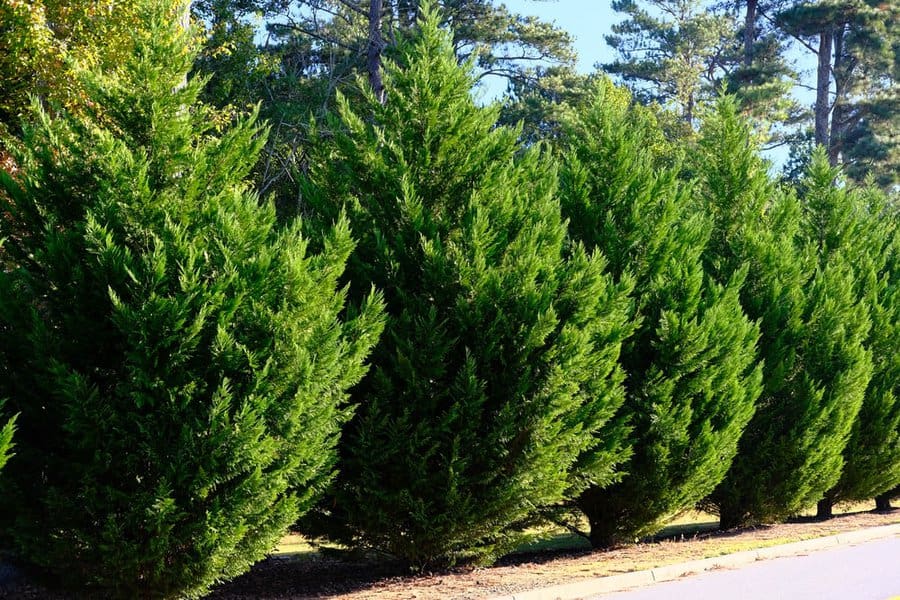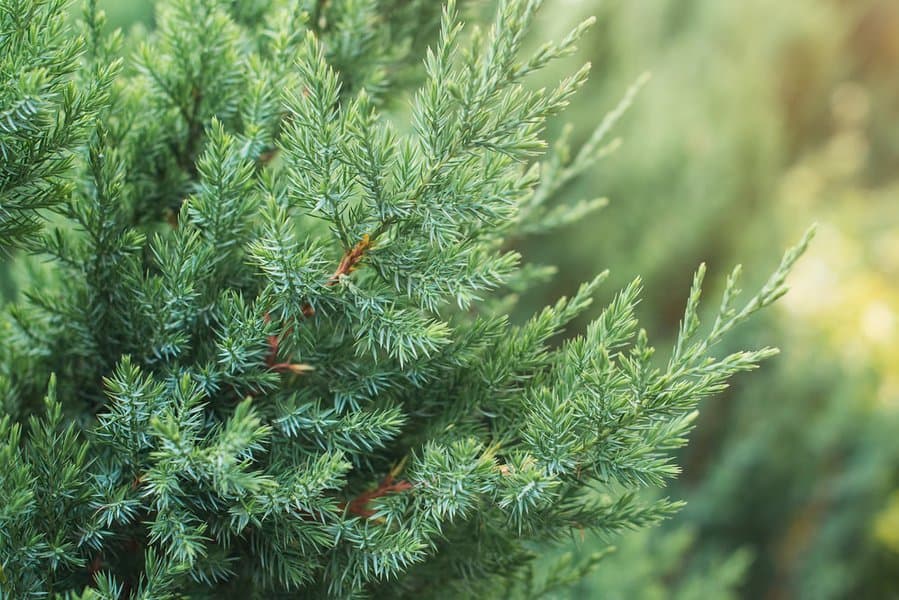Are you looking for a natural way to add some privacy to your land? Murray cypress trees are popular and fast-growing evergreen trees that have gained popularity for their quality as privacy trees and Christmas trees. Additionally, this species can handle harsh weather and is beautiful to look at while offering some cover. Read on to learn how to expertly care for this tree.
Table of Contents
Murray Cypress Overview
The origin and classification are debated amongst arborists and scientists, but the most widely agreed upon theory is that this species is a cultivar or variety of Leyland cypress trees. The key difference between the two species is that the Murray cypress tree has sturdier branches, more vibrant foliage, stronger tolerance to extreme cold, and is more disease resistant.
The Murray cypress tree is an evergreen species that belongs to the Cupressaceae family. This family produces conifer trees that can grow very tall and includes well-known Juniper and Redwood trees. Murray cypress trees belong to the genus Cupressus which is home to many species of cypress trees.
The Murray cypress tree is referred to as the privacy tree, or more scientifically, the X Cupressocyparis leylandii. As stated earlier, scientists and botanists have varying theories on where this species originates. In addition to the Leyland cypress theory, some scientists believe this species is a hybrid produced from C. nootkatensis (Alaska cypress) and C. lusitanica (Mexican cypress). Others claim the Murray cypress came from Wales in a small garden around 1888.
Other notable family members of the Murray cypress tree are the Leyland cypress, Mexican cypress, and Monterey cypress.
Leyland cypress: This cypress tree has dense foliage with scale-like needles similar to the Murray cypress but is less sturdy.
Mexican cypress: This is a cypress variety with drooping branches and thick reddish-brown bark. This species is highly desired for use in the lumber industry.
Monterey cypress: This species is also called the Lemon cypress and is often used ornamentally. It coined its nickname due to the strong lemon smell and yellowish-green color.
| Botanical Name | X Cupressocyparis leylandii |
| Family | Cupressaceae |
| Genus | Cupressus |
| Origin | Hybrid / cultivar |
| Sunlight | Full sun to partial shade |
| Temperature | -5 to 35 °F. |
| Propagation | Vegetative cuttings |
| Re-Potting | Once too large for the current container |
| Pests and Diseases | Cankers and needle blight |
| Toxicity | Toxic sap can potentially harm humans and pets |

Murray Cypress Tree Features
The beauty of the Murray cypress tree comes from its rapid growth rate and tall height. These factors make the species great for use in a privacy fence or even as a Christmas tree. Upon reaching maturity, a Murray cypress tree can grow up to 50 feet tall and spread 12 feet apart.
The leaves on the Murray cypress are needle-like, creating a dense foliage layer, adding to their great ability to be a privacy tree. This cypress species, Murray, produces cones that hold the seeds used for natural reproduction and do not produce fruit.
Another factor to keep in mind is the toxicity of the sap found inside the tree. Some may have allergic reactions when contacting the sap, so be mindful of kids and pets coming into contact with these trees.
Murray Cypress Care Guide
Caring for the Murray cypress is fairly straightforward but requires more attention when the plant is a baby tree and establishing itself. This tree enjoys full sun, partial shade in moderation, and moderate watering in the beginning.
The Murray cypress is well-renowned for its cold hardiness and ability to survive in a wide range of temperatures. Additionally, a mature Murray cypress is drought tolerant, allowing it to grow successfully in various climates and environments. Well-draining soil is an important requirement, while humidity levels can be flexible.
Related Article: pH of The Soil – Why Is It Important
Ideal Growing Place
The Murray cypress green giants are mainly planted outdoors since they can grow to massive heights with their rapid growth rate. This evergreen plant needs plenty of space to fill out and ensure healthy foliage. Furthermore, many homeowners use this species as privacy trees or as a way to indicate a property line.
Rapid growth and the growing season begin in the early springtime around March. During the fall, starting in November, the species’ dormancy period arrives, and the cypress tree growth rate slows down. If you want to add this landscaping giant to your property, the best time to plant is during the dormancy period. Avoid planting when temperatures are below freezing, as this can harm your sensitive and young root system.
Water
Frequent watering of your Murray cypress is extremely important, especially in the first three months after planting. You don’t want dry soil. During this time, watering your cypress with a weekly dose is recommended. One gallon of water per foot is a good rule of thumb. For example, if your trees are 20 feet tall, water them once per week with about 20 gallons of water.
It is also a good idea to check the soil moisture level to avoid overwatering. Gently dig up about four inches of soil around the base of your Murray cypress and check the moisture level. If you consistently find soggy soil, reduce the water amount used.
Sunlight
The optimum lighting to ensure healthy foliage is full sun, especially when the plants are young and cannot reach the natural light on their own. Provide at least six hours of full sun each day. However, if this cannot be achieved, partial shade can be sufficient for the tree but does not provide the best conditions.
Temperature
The Murray cypress tree can withstand various temperatures, allowing it to grow in many environments across the country successfully.
Soil
The Murray cypress tree prefers a well-draining soil mixture that falls in the pH range of 5-8. Checking soil drainage for this species is easily done by testing an area of soil. Dig a soil area around 18 inches deep and wide, then fill with water. If this soil area takes longer than one hour to drain, it has poor drainage and is unsuitable for growing this species. Adding peat moss, compost, and manure can help adjust the pH levels in the soil as well.
Humidity
Humidity is not a deal-breaker when deciding where to plant your Murray cypress tree. This species is adaptable to many levels of humidity, especially those in their growth zone.
Fertilizer
If you have just planted your Murray cypress tree, giving it a nutritional boost with a slow-release fertilizer is a good idea. Ensure fertilizer is low in nitrogen, as this can harm a younger tree’s root system.
After this initial dose of fertilizer, your tree should be nutritionally boosted for the next three months. After your tree has become more established, especially the roots, you can provide more fertilizer when needed.
Pinching/Pruning
Once your Murray cypress tree gets to be about three feet tall, you can begin pruning the tree to desired thickness and height. When it is still small, avoid pruning more than three to four inches from the sides of the tree.
If you are going for a shorter cypress tree look, prune from the top of the central branches. If you want your tree’s foliage to come in denser, begin pruning 12-13 inches from the top of the desired height.
Potting and Re-potting
As your Murray cypress tree grows, you will need to repot it until it can be planted outdoors and grow on its own. When you need to provide a bigger pot, gently remove the tree from its current home and carefully remove excess soil. Then, place the plant into a slightly larger pot and surround it with new soil. Lastly, give it fresh watering and allow proper drainage.
Growth Zone
The Murray cypress tree can grow in many areas of the United States. USDA Plant Hardiness Zones 6-11 are suitable for growing this species outdoors. These zones encompass the lower half of the United States and the northwest regions of California, Oregon, Washington, and parts of Idaho.
Common Pests, Toxins, Diseases & Other Problems
Murray cypress trees are highly regarded as being pest and disease resistant. Even so, every plant is affected by something. This species is susceptible to cankers and needle blight. Cankers are sections of dead wood or bark found on a tree and are caused by a fungus, bacteria, and even nonliving factors like hail or other damage.
Needle blight is a disease caused by fungus and can affect the needles and bark of your Murray cypress tree. The best preventative measure for this is to properly space your trees as they grow to allow air circulation.
Murray Cypress Propagation
The best way to propagate your evergreen cypress tree is by taking leaf cuttings. Locate a healthy foliage section, and cut a four to eight-inch cypress branch using sterilized tools. Next, make a one to two-inch vertical cut into the bottom of the cutting and remove two inches of leaves from the bottom.
Once your cutting is prepared, place it into a pot with perlite and sand soil mixture, packing the mix tightly around the cutting—water the pot and cutting well and allow drainage of the excess water. Cover the pot with plastic wrap to encourage humidity and place the pot in a warm and sunny area to promote root growth.
Murray Cypress Evergreen Mature Timeline
After propagating your Murray cypress evergreen, it will take around two to three months to see substantial root system growth. After roots are a few inches long, your cutting can be replanted and be on its way toward maturity.

Murray Cypress Plant FAQ
How Big Do Murray Cypress Get?
Murray cypresses can grow to a whopping height of around 50 feet. This makes them great privacy evergreen trees to cover your yard or property.
How Fast Does Murray Cypress Grow?
The Murray cypress has a rapid growth rate. This tree can grow 3 feet in just one year.
When Should Murray Cypress Be Planted?
The best time to plant the Murray cypress is during the dormancy period of fall and winter. Keep an eye on temperatures, and do not plant your Murray cypress when temperatures are below freezing.
Is Murray Cypress Invasive?
While the species is not invasive, the root system of this tree can expand underground and travel.
Are Murray Cypress Trees Rare?
Murray cypress trees are fairly common and often used in landscaping. These trees have gained popularity over time due to their fast growth rate and height.
Are Murray Cypress Trees Toxic to Cats, Dogs, and Humans?
The sap in the Murray cypress tree can be poisonous and toxic to pets and humans. Allergic reactions have been noted by some coming into contact with the sap, so be sure to watch children and pets near the trees.
Will Murray Cypress Grow in Shade?
Partial shade for about four to six hours a day is sufficient for the Murray cypress, but it is not as ideal as providing full sun.
Do Deer Eat Murray Cypress Trees?
Murray cypress trees are susceptible to deer, especially when young, and have smaller, more tender branches. Deer will enjoy those branches as a snack and can use the tree trunks to rub their antlers on.
What Are Common Murray Cypress Problems?
While the Murray cypress is very pest and disease resistant, issues like cankers and needle blight can harm your trees.
What’s the Difference Between Murray Cypress vs. Green Giant?
The main difference between Murray cypress and the Green giant is the temperature range. The green giants have a higher tolerance for high heat and humidity, while the Murray cypress is cold-weather hardy.
The Bottom Line
If you want to add the best privacy tree to your property or home, look no further than the Murray cypress tree. This species is easy to care for, has fast growth, and looks beautiful as a fence or property line. The dense foliage, pest and disease resistance, and temperature tolerance make this plant special. After reading our care guide, you are well on your way toward becoming a Murray cypress expert!
Last Updated on August 27, 2022 by Gustaf Johansson




